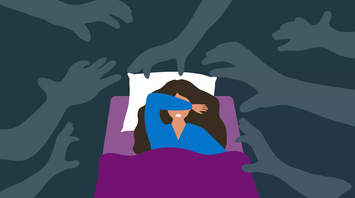How to Get Rid of Bad Dreams

Bad dreams can disrupt sleep and lead to discomfort. These nightmares often stem from stress and trauma. Fortunately, several techniques can reduce the occurrence of these dreams, thus restoring peaceful sleep. Here, we outline effective methods to help prevent bad dreams.
Method 1: Taking Action During the Day
Step 1: Don't Dwell on Nightmares
Avoid fixating on nightmares. Though they can be terrifying, worrying about them amplifies stress, increasing the likelihood of future bad dreams. Instead, concentrate on positive experiences. Visualizing a loved one or safe space can shift your mindset toward positivity.

Step 2: Leave Worries Behind
Don't take your concerns to bed. Dwelling on negative thoughts can lead to bad dreams. Instead, as you drift off, focus on your breathing. Gently observe each inhalation and exhalation. If your thoughts meander, kindly return your focus to your breath, allowing your mind to calm.
Step 3: Monitor Your Thoughts
Pay close attention to your thoughts throughout the day. If you find yourself amplifying anxieties, pause. Recognizing these thought patterns enables you to shift toward positive thinking, thereby reducing unnecessary stress.
Step 4: Visualize a Safe Space
When feeling anxious, visualize a safe environment. This mental exercise can help relieve anxiety temporarily. Imagine a space where you feel secure and relaxed. Engage all your senses in the visualization, and spend several minutes immersed in this calming imagery.

Step 5: Reflect on Your Actions
Consider your daily behaviors. Negative feelings often lead to further unhelpful actions. If you engage in unproductive habits like excessive drinking, it's time to stop. Instead, find healthier alternatives, such as exercise or meditation, to alleviate stress.
Step 6: Try Imagery Rehearsal Therapy
Use imagery rehearsal therapy if you experience frequent negative dreams. Start by writing down your nightmare in detail. Modify aspects of the dream, or create a positive version in which you encounter desired scenarios. Visualize this new dream regularly.
Method 2: Understanding Nightmares
Step 1: Identify Nightmare Causes
Learn the main causes of nightmares, which affect both children and adults. Two significant triggers include stress and significant life events, such as loss or trauma.
Step 2: Recognize Other Triggers
Consider additional factors contributing to nightmares. New medications may lead to disturbed sleep, as can alcohol. Avoid eating right before bed, as increased metabolism can disrupt sleep. Illness, especially with a fever, may also indicate why nightmares occur.

Step 3: Look for Patterns
Analyze your nightmares for common elements. Recurring patterns may point to root causes like PTSD, prevalent in individuals exposed to traumatic events, or severe anxiety. Seek professional support to address these underlying issues.
Step 4: Understand Various Sleep Disturbances
It's crucial to distinguish between bad dreams, nightmares, and sleep terrors. Bad dreams can be unpleasant but do not disturb sleep, while nightmares can induce awakening due to fright. Sleep terrors, on the other hand, arise as intense fear without accompanying dream images.
Step 5: Consult a Doctor
Consult your healthcare provider about persistent nightmares. They may offer medication options or recommend over-the-counter sleep aids. Common options include melatonin, doxylamine, valerian, and diphenhydramine. Be cognizant of potential side effects and interactions.

Method 3: Improving Sleep Quality
Step 1: Enhance Sleep Habits
Improve your sleep patterns to reduce the likelihood of nightmares. Develop good habits, including regular exercise, reduced caffeine, and alcohol intake. Engage in enjoyable activities and practice relaxation techniques. Maintain a consistent sleep schedule for substantial rest.
Step 2: Relax Muscle Tension
As you prepare for sleep, practice tensing and relaxing your muscles. Start with your head and shoulders, releasing tension as you descend your body. This method has been shown to lessen nightmares significantly.
Step 3: Sleep Environment Restriction
Designate your bedroom exclusively for sleep. Refrain from engaging in wakeful activities such as reading or watching TV in bed. This mental signal will help foster association with rest, promoting deeper and quicker sleep.
Earlier, SSP wrote about spiritual meanings of four-leaf clover.



















